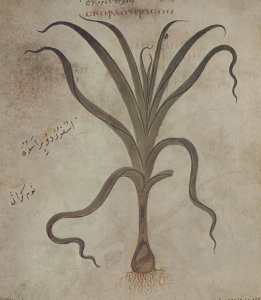In my last blog post, I discussed some ancient gender tests. This month, I turn to Greek fertility tests. In the Greek world, women only entered full womanhood upon conception and delivery of a child, preferably a boy. Infertility seriously damaged a woman’s status in her community. It is therefore no wonder that one of the treatises of the Hippocratic Corpus (a collection of some sixty texts written in the fifth and fourth centuries BCE) was devoted to the issue of barrenness: On Sterile Women. This tract includes a few fertility tests, aimed at predicting whether a woman will become pregnant or not.
Tests by means of which you will know whether a woman will be pregnant. If you want to know whether a woman will be pregnant: give to drink butter [or a plant called boutyron] and the milk of a woman who has borne a male child, whilst she is fasting. If she vomits, she will be pregnant; if not, she will not.
Another: Let her wrap some oil of bitter almonds in wool and apply as a pessary. Check in the morning whether she smells of it through the mouth; if she smells, she will be pregnant, if not, she will not.
Another test for the same purpose: apply pessaries that are not particularly strong. If she has pains in the joints, suffers from clattering teeth, dizziness, and yawning, there is more hope that she will pregnant than if she who does not suffer from any of these afflictions.
Another: Having washed and peeled a head of garlic, apply it to the womb, and see the next day whether she smells of it through the mouth; if she smells, she will be pregnant, if not, she will not.
If you want to know whether a woman will be pregnant, let here drink finely pounded anise in water, then let her sleep. If she itches around the navel, she will be pregnant; if not, she will not. [On Sterile Women 214]
Every single one of these tests would deserve a long explanation, especially since possible Egyptian parallels exist for some of these recipes. Here, however, I will focus on the second and fourth tests, the almond oil and garlic tests. Both rest upon the assumption that women have a sort of tube (a hodos) that runs through their bodies, with two openings: the mouth of the face and the mouth of the womb (=the vagina). In a healthy woman, whose tube was not obstructed, a smell could travel easily from the lower to the upper mouth – hence the use of such smell test.
The smells used here were not chosen at random. Perfumes, such as that of bitter almond, were associated with Aphrodite, love making and marriage ceremonies. Garlic too was associted with sexuality and fertility, although the links are not particularly easy to interpret. In Aristophanes’ comedy, The Women at the Thesmophoria (a festival in honour of Demeter), women use garlic to conceal the smell of wine after a night of drinking and sex with their lovers (v. 495). Garlic masks the smells associated with sex and pleasure. Similarly, according to the historian Philochorus (third century BCE), at the festival of the Skirophoria (a festival in honour of Athena and Demeter), ‘women ate garlic in order to abstain from sex, so that they would not smell of perfume’ (FGRH 328 F 89). Thus, Philochorus presents garlic as an-aphrodisiac, a clear opposite to those perfumes used in sexual foreplay.
The sceptic will no doubt say that garlic was chosen simply because it is a strong smelling, ‘windy’ plant, whose scent would travel easily through the body. Yet, there seems to be something that links it to women and sex in the ancient world. An admittedly much later document, a sacred law from the sanctuary of the healing god Men at Sounion in Attica (IG II2 1365) informs men that they should cleanse if they have been in contact with garlic, pigs and women — a rather puzzling combination unless you know that ‘piggy’ was Greek slang for the vulva.
 Print This Post
Print This Post 

Great post Laurence, I have had an article accepted talking about these types of tests in the early modern period. Wish I had had this information to include.
Pingback: Giants’ Shoulders #65: The Wallace Edition | The Renaissance Mathematicus